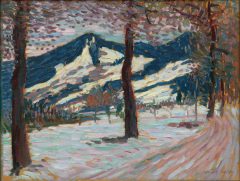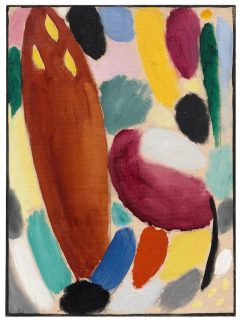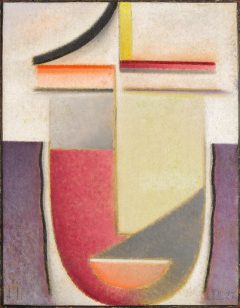Louisiana Museum of Modern Art, Humlebæk:
"Alexej Jawlensky"
January 30 - June 1, 2025
Though closely associated with the European avant-garde movements at the beginning of the 20th century, the painter Alexej Jawlensky (1864-1941) seems to have found his very own artistic voice rather late in life. This exhibition focuses on Jawlensky's path towards a highly distinctive expression in the form of his small, beautiful and mysterious meditations.
Alexej Jawlensky was born into a regimental family in Russia in 1864, and initially opted for a military career himself, which he, however, chose to abandon in favor of the arts. In 1889 he began studying at the art academy in St. Petersburg, where he met the painter Marianne von Werefkin, who became his partner and supporter for many years. Together, the couple moved to Munich, where Jawlensky attended a private painting school with, among others, Wassily Kandinsky.
The first chapter of the exhibition in fact focuses on Jawlensky's connection to the art scene in Munich at the beginning of the 20th century. Together with Kandinsky, Gabriele Münter and Werefkin, he settled for a period in Murnau in Upper Bavaria and developed his highly expressive landscape paintings here.
In early 1909 he became a founding member of the “Neue Künstlervereinigung München” and closely connected to the famous artist movement “Der Blaue Reiter”, initiated by Wasilly Kandinsky and Franz Marc, which emerged in Munich a few years later. This is the period where Jawlensky increasingly turns to the portrait as a motif, which in his case takes on a colourful, stylized expression, where particularly large eyes stand out as a dominant factor.
The exhibition's second chapter takes its point of departure in Switzerland, where he, as a Russian, was forced to move into exile after the outbreak of the First World War. Here he and Werefkin settled by Lake Geneva, and as he did not have an actual studio, he painted the view from his window over and over again.
These images are called variations and represent the beginning of Jawlensky’s interest in serial images, in the repetition of the motif. The more he painted, the more his works seemed to lose their connection to the “seen”, to the outside world. The image’s own logic took over and became the governing factor.
Das dritte Kapitel der Ausstellung befasst sich mit Jawlenskys letzten Jahren in Deutschland in den 1930er Jahren. In den letzten beiden Jahrzehnten seines Lebens ist es die Wiederholung des Motivs, die ihn beschäftigt. Zunächst in Form der Variationen und schließlich hier mit den sogenannten Meditationen.
Die Meditationen können als eine Art glücklicher Abschluss für einen Künstler betrachtet werden, der fast sein ganzes Leben lang versucht hat, seine spirituellen Überzeugungen mit dem Akt des Malens zu verbinden. Er schuf etwa tausend dieser sehr schönen und geheimnisvollen kleinen Meditationen, die alle aus demselben schwarzen Raster bestehen, das mit Farbkombinationen durchsetzt ist. Das war alles, was seine arthritischen Hände ihm erlaubten, aber in gewisser Weise war das alles, was er sich wünschen konnte. Er hatte sein Lebenswerk zum großen Teil vollbracht.
LAST BUT NOT LEAST
We are delighted to support the exhibition with the loan shown opposite.



